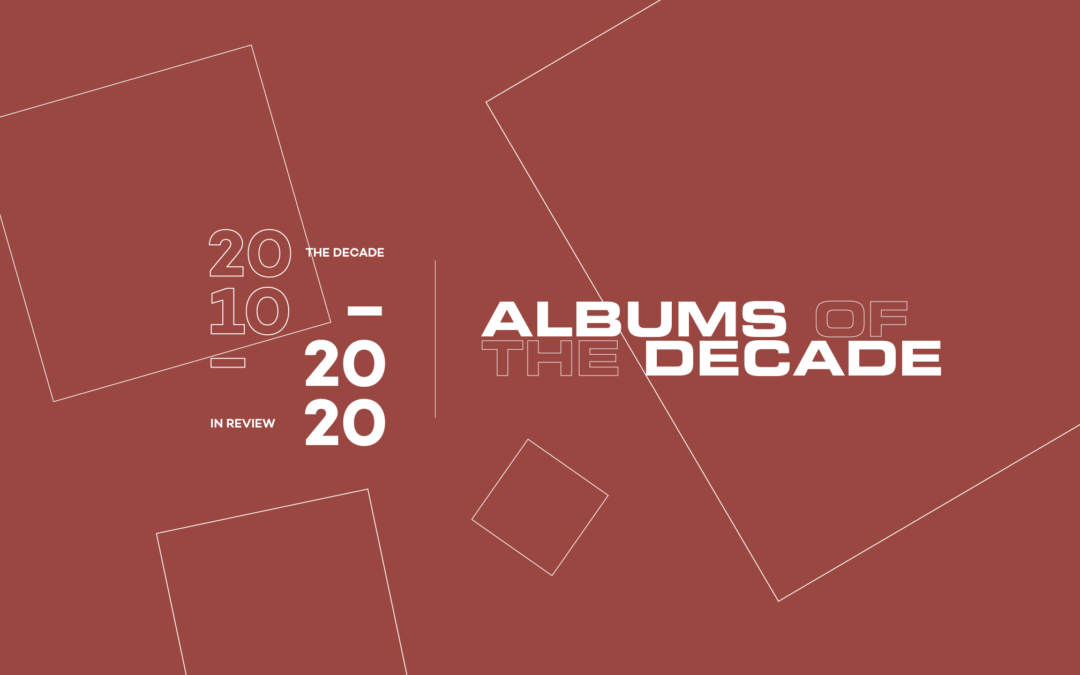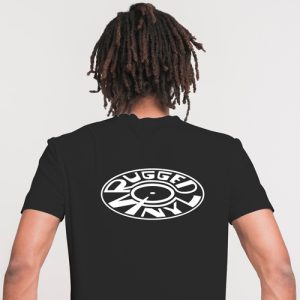ACTRESS ‘SPLAZSH’ (HONEST JON’S RECORDS)
Actress has spent the latter stages of this decade spreading his artistic wings, collaborating on complex live performances with orchestras and even an Artificial Intelligence he created. Going back to 2010, you can see the clear signs of his impressive range on second album ‘Splazsh’. A solo effort produced in a South London bedroom, the 14-track release is a boundary breaking opus tying together garage, techno, pop, dubstep and more. It was revolutionary at the time, when genre guidelines were more rigidly stuck to. Actress labelled this style “r’n’b concrète”, and while a first glance at track title ‘Supreme Cunnilingus’ may seem more relevant to the former, he explained the title as referring to being “so into your computer, it might as well be giving you a blowjob”. Through the guitar licks of ‘Purrple Splazsh’, emotive melody of ‘Maze’, and seductive blend of vocals and loops on ‘Senorita’, Actress found the sensuality in experimental computer music. Patrick Hinton
SKRILLEX ‘SCARY MONSTERS AND NICE SPRITES’ (MAU5TRAP / BIG BEAT)
This music will rot your teeth and make your eyes bulge – the aural equivalent of eating a fistful of Warheads and downing it with Mountain Dew. Kids went crazy for the adrenalin rush of ‘Scary Monsters…’ and, like all good youth music, it pissed the hell out of elder “heads” who decried it as the end of dance music, mainly because it turbo charged dubstep into a global mainstream phenomenon and fed directly into the North American EDM juggernaut. But there’s genuine energy in the way Skrillex balled up electro house, wobble dubstep, trance and a sprinkling of emo (“All I ask of you / Just open up a little bit more” goes the vocal on ‘All I Ask Of You’) and pitched it back out to the world as an insurgent new form. Skrillex rode the hype that this mini album created to the crest of the EDM wave before bailing out, his status as a superstar intact. Seb Wheeler
RUSTIE ‘GLASS SWORDS’ (WARP)
There’s a very particular ultra-shiny, ultra-hi-fi aesthetic, with alien voices, fragmented funk, and a whole lot of piercing high end, that’s absolutely everywhere now. From the pop charts to the most out-there deconstructed club music, it’s the sound of now. Lots of people can claim credit for developing this, but there is one album above all that coalseced it and set the tone for the whole decade: ‘Glass Swords’. From beginning to end, it’s overwhelming in its surges of rave energy, pop fizz, prog rock grandiosity, and everything else plus the kitchen sink. Eight years on, it still sounds immense. Joe Muggs
SBTRKT ‘SBTRKT’ (YOUNG TURKS)
Once every few years, an album comes along that unites the house heads, the hipsters and the soul/r ‘n’ b elite – and releasing on Young Turks is a sure-fire way to artfully combine all three to critical and commercial acclaim, which is what SBTRKT did back in 2011. Not only were the guests premiere league (Little Dragon, Jesse Ware and later Drake) but it also helped launch Sampha into the stratosphere thanks to flawless song-writing and cutting-edge production on ‘Hold On’, ‘Trials Of The Past’, ‘Something Goes Right’ and ‘Never Never’ which helped gave the album a soulful, late night cohesion. Wildfire, meanwhile, is still an undisputed banger that demands a rewind and remains the album’s biggest gold-plated moment. “The main thing is the synths, arrangement and syncopation,” he told Fabric ahead of the album release. “Also, I am not Switch!” Ralph Moore
KUEDO ‘SEVERANT’ (PLANET MU)
Near the start of the decade, Keudo gave us an insight into the future. As we approach 2020, ‘Severant’ still sounds ahead of our current time. Blade Runner and the music of Vangelis was a key inspiration behind the record, informing its emotionally rich synths, polyphonic tones and expansive, reverb-soaked textures. And like viewing Ridley Scott’s 1982 classic before this final year of the 2010s, listening to ‘Severant’ in 2019 evokes a feeling akin to watching an old-skool sci-fi film predicting an unforeseen future. An aching nostalgia permeates through the 15 futuristic tracks; it’s tangibly from the past and yet feels like it’s beaming back to us. A superbly deployed, and just barely recognisable in its electronic warping, Carly Simon sample underscores the timeless feel. Patrick Hinton
CLAMS CASINO ‘INSTRUMENTALS’ (TYPE)
With credits on tracks by the likes of Mac Miller, Vince Staples, A$AP Rocky, Lil B, Danny Brown, Lil Peep and more, Clams Casino is one of the definitive rap producers of the decade. He started 2011 as a relative unknown who’d made some beats for rappers like Lil B and Soulja Boy. Self-releasing a number of these productions on his debut mixtape ‘Instrumentals’ quickly changed that. It was picked up for physical release via Type, a debut EP followed soon after on Tri Angle, and he closed out the year with multiple credits on A$AP Rocky’s acclaimed first mixtape ‘Live. Love. ASAP’. From there his distinctively atmospheric and lo-fi production style helped pioneer the nascent cloud rap and mumble rap scenes, alongside contemporaries like Clouddead, Yung Lean, Kid Cudi and frequent collaborator Lil B.
‘Instrumentals’ is Dilla-like in its heavy use of samples and beats standing alone as works of art, but sounded fresh through wrapping recognisable cues up in emotionally devastating soundscapes. Adele’s voice provides heart-tugging heft in the foundations of ‘Realest Alive’, Imogen Heap’s airy tones are weaved into the captivating textures of ‘I’m Official’, and the sound of Björk’s voice is at its most gripping in between the intense synths of ‘Illest Alive’. Tracks like ‘She’s Hot’ and ‘Brainwash by London’ equally showed his ability to craft tunes on a late-night sensual and club-ready tip. For many, ‘Instrumentals’ was the compelling introduction to a pivotal player in hip hop. Patrick Hinton
ROMAN FLÜGEL ‘FATTY FOLDERS’ (DIAL)
Roman Flügel has become such a household name in the house and techno sphere this decade, it’s easy to forget how broad his output was pre-2010. From abstract stylings crossing the spectrum of ambient to IDM as Eight Miles High to brash electro alongside Jörn Elling Wuttke as Alter Ego to atmospheric minimal as Soylent Green, Flügel is a musical polymath. He even contributed to the rise of the electro house scene with proto-EDM banger ‘Geht’s Noch?’, setting the “Dirty Dutch” blueprint further popularised by global giants like Afrojack and Chuckie.
Released in 2011, ‘Fatty Folders’ was Roman Flügel’s first album under his given name. It marked the German’s most cohesive artistic statement to date. Opening on dreamy textures with ‘How To Spread Lies’ and moving through to tender coda ‘PianoPiano’ via the rich deep house of ‘Bahia Blues Bootcamp’, mesmeric Krautrock-inspired ‘Krautus’, organic thrust of ‘Deo’ and more, ‘Fatty Folders’ asserted Flügel as a master of transportive deep house, and more than a jack of all trades. Its influence has carried through to current global superstars such as Peggy Gou, who credited the record for turning her onto underground sounds in our 2016 Impact feature: “I was like ‘What the fuck is this!’” she said. “I didn’t know what it was but it sounded so amazing.” It still does. Patrick Hinton
DAPHNI ‘JIAOLONG’ (JIAOLONG)
This was Dan Snaith’s debut project under the moniker Daphni in 2012. It’s an LP full of house tunes with some psychedelic vibes bursting through at points. What sets Daphni apart from Snaith’s other recording personas, is the dancefloor-orientated sound, and this album showcased that new direction.
‘Jiaolong’ was a highly anticipated album from fans after a year of singles leading up to its release. ‘Ye Ye’ was a massive club hit when it dropped only a few months before the full-length in 2012, and rightfully so. It’s addictive beats were made for a sweaty dancefloor. Daphni’s beautiful remix of afro-beat track ‘Cos-Ber-Zam Ne Noya’ instils a desperate need to dance and makes you pine for the next time you’ll be at a dingy underground rave. Lydia Webb
MARTYN ‘GHOST PEOPLE’ (BRAINFEEDER)
The second album from Dutch producer Martijn Deijkers was a masterclass in expanding one’s range. Having emerged from the vaporous smoke of the London-based dubstep scene, Martyn had already shown signs of branching out on his 2010 ‘Fabric.50’ mix and, a year earlier, a spectacular house remix of Fever Ray’s ‘Seven’. ‘Ghost People’ took these progressions several steps further without ever losing the commitment to atmosphere or detail that had made his dubstep work stand out.
Metallic synths and a commitment to bass were still high on the agenda, but reframed in spectacular ways: the pummeling hammer blows of lead single ‘Viper’ hung in mid-air, beatless but for a dusting of snares; breakbeats and trance synths combined for a maximalist explosion on ‘Popgun’. Towards the end of the album, Martyn seems to overflow with ideas as the electro thrum of ‘Bauplan’ gives way to a martial tattoo to close ‘Horror Vacui’ and, finally and most thrillingly, some old-skool rave magic ushering in the hands-in-the-air climax of ‘We Are You In The Future’. It’s a fittingly celebratory finale for an artist finding his voice – one that he has continued to explore ever since. Alex Macpherson

JAM CITY ‘CLASSICAL CURVES’ (NIGHT SLUGS)
Like Frankie Knuckles pioneering house music with his record selection at Chicago’s The Warehouse or Paul Oakenfold, Johnny Walker, Danny Rampling and Nicky Holloway dropping a pill at Amnesia and spreading the gospel of Balearic back in Blighty, ‘Classical Curves’ was the foundational genesis of a movement. Although the deconstructed club trend predated this record through genre-mashing parties like Wildness in LA and GHE20G0TH1K in New York, ‘Classical Curves’ marked the most refined and accessible blueprint for the stripped-back style of music. An entire scene united around the LP – from the pneumatic fashion shoot stylings of ‘Her’ to the shoe squeaks and stuttering bassline of ‘The Courts’ to the staccato rhythms and throwback synths of ‘How We Relate To The Body’ – and embedded its influence into their ensuing output. It was ground zero for one of the most prominent club music trends this decade. Patrick Hinton
SESSION VICTIM ‘THE HAUNTED HOUSE OF HOUSE’ (DELUSIONS OF GRANDEUR)
The UK house wave that emanated around 2011-12 was driven by big baselines and peak-time vocal samples. But elsewhere in Europe a deeper groove was being forged by artists like Sven Weisemann, Move D, Christopher Rau and Session Victim, the German duo responsible for one of the most consistent house LPs of the decade: ‘The Haunted House Of House’.
You won’t be spooked by such a warm, uplifting album but it does induce a hypnagogic state, one reminiscent of high times on dancefloors and during crack-ons, those moments where everything comes together and life is perfect. The tracks are drenched in soul and move with jazzy fluidity, making rigid, monochrome 4/4 sound completely boring in comparison. Highly capable DJs, Session Victim’s live show is also a force to be reckoned with, alongside peers such as Juju & Jordash and Magic Mountain High. Seb Wheeler
MALA ‘MALA IN CUBA’ (BROWNSWOOD RECORDINGS)
There was some confusion when ‘Mala in Cuba’ dropped. Did hooking up with Gilles Peterson and Brownswood, and recording live musicians in Cuba mean that the Digital Mystic was stepping away from purist bassweight meditations? Was this a move towards coffee table, broadsheet, jazzy respectability? It certainly does sound nice on a swanky hi-fi with a glass of wine, that’s for sure. But no, this is still heavyweight dub too. Put together with underground Zelig DJ Simbad and some astouding Cuban players, bang this up loud and it’s still unmistakably the sound of DMZ: spiritual, spacious, and annihilatingly powerful. Joe Muggs
SCUBA ‘PERSONALITY’ (HOTFLUSH RECORDINGS)
Like the worlds of 2-step and dubstep from which his Hotflush imprint emerged, Scuba exhibited a penchant for tense, shady productions on his first two albums that, indicative of his alias, often sounded as if they were coated in some sort of slick, watery murk.
So, when the artist began releasing endorphin-spiking, goosebump-prickling music, such as his ‘Adrenalin EP’, eyebrows and lighters were raised in equal measure. Some thought it was “pretty terrible,” though ‘Never’ remains one of my favourite tracks of all time.
2012’s ‘Personality’ is cut from the same cloth, a gorgeous tour through techno, breezy IDM and Sasha-style prog house that would make even the most ardent of pessimists turn to the bright side, urged on by the cardio pump of ‘Action’ and the doved-up, strobe-searching highs of ‘NE1BUTU’. Even the darker moments on the project, namely ‘The Hope’ and ‘Gekko’, are flush with a sincere sense of fun.
Far from a singular moment, dance music was dominated by exciting, technicolour bangers during this period, from Bicep and Ejeca’s soaring ‘You’ to NY Stomp’s turbo-jacking ‘The NY House Trak’, a chink of piercing light following dubstep’s shadowy moment — ‘Personality’ captured this halcyon time to a tee. James Ball
(Via Mix Mag)







